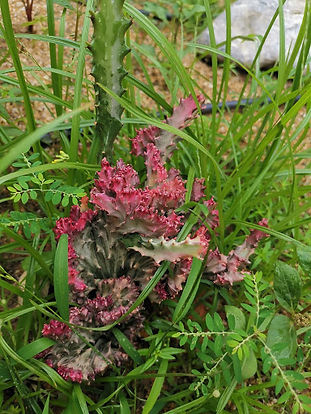
Ecopond (outside Chemistry Labs)

Water Lily
Nymphaeaceae is a family of flowering plants, commonly called water lilies. They live as rhizomatous aquatic herbs in temperate and tropical climates around the world.

Thalia Geniculata
Thalia geniculata, the bent alligator-flag, arrowroot, or fire-flag, is a plant species widespread across tropical Africa and much of the Americas.
.jpg)
Stratiotes alludes
Known as water soldiers. Their leaves are very brittle, breaking easily when handled.
.jpg)
Moses-in-the-cradle
Tradescantia spathacea, the boatlily or Moses-in-the-cradle, is a herb in the Commelinaceae family first described in 1788.

Dracaena trifasciata
Dracaena trifasciata is a species of flowering plant in the family Asparagaceae, native to tropical West Africa from Nigeria east to the Congo.
.jpg)
Euphorbia Lactea
A species of spurge native to tropical Asia, particularly India. It is a succulent. Succulent plants have parts that are thickened and flashy. These adaptations help it to retain water in dry climate and soil conditions.

Aloe Vera
Native to North America, Southern Europe and the Canary Islands, the Aloe Vera is cultivated for agricultural and medicinal uses. It is also used for decorative purposes and grows successfully indoors as a potted plant. It is found in many consumer products, including beverages, skin lotion, cosmetics, or ointments for minor burns and sunburns. Currently, researchers are even claiming it relieves heartburn, potentially slows the spread of breast cancer, or even as an alternative to mouthwash! The possibilities are endless!

Century Plant
Part of the family Asparagaceae, which is the family for asparagus plants. Its flower stalk can reach a whopping 8 metres in height!

Euphorbia geroldii
Euphorbia geroldii is a species of plant in the family Euphorbiaceae. It is endemic to Madagascar. Its natural habitat is subtropical or tropical dry forests. It is threatened by habitat loss.

Barrel cactus
Found in the deserts of Southwestern North America, some of the largest specimens can be found in the Mojave desert in Southern California (1m to 3m). They grow into a squat tubular shape, giving the appearance of a spiked ribbed barrel. The genus name ferocactus is Latin for 'fierce cactus' as seen from the densely-packed, stiff spines covering the fleshy plant. The genus name echinocactus derived from Ancient Greek, meaning 'spiny'. These spines are strong enough to be used to make fishing hooks!

Agave angustifolia
Agave Angustifolia 'Marginata' is a plant which is native to Mexico and Central America, and is an evergreen succulent (having thick fleshy leaves or stems adapted to storing water). It is used to make mezcal (a type of distilled alcoholic beverage) and also used as an ornamental plant. This species is drought-tolerant when grown in the ground, but yet as not drought-tolerant as other agave species.

Euphorbia lactea
Euphorbia lactea is a species of spurge native to tropical Asia, mainly in India. It is an erect shrub growing up to 5 metres tall, with succulent branches 3–5 centimetres diameter

Yellow Elder (Tecoma Stans)
Tecoma stans is a species of flowering perennial shrub in the trumpet vine family, Bignoniaceae, that is native to the Americas
.jpg)
Parrot Heliconia (Heliconia psittacorum)
A perennial herb native to the Caribbean and South America. It is considered native to French Guiana, Guyana, Suriname, Venezuela, Colombia, Bolivia, Brazil, Paraguay, Panama and Trinidad and Tobago. It is reportedly naturalized in Gambia, Thailand, Puerto Rico, Hispaniola, Jamaica and the Lesser Antilles. It is often cultivated as a tropical ornamental plant in regions outside its native range. Unlike most species of plants that require the use of pollinators for pollination the H. Psittacorum naturally prefers the absence of pollinators for pollination.
.jpg)
Yellow Trailing Lantana (Lantana montevidensis)
Trailing lantana plants, native to Southern Brazil, Argentina, Paraguay, Uruguay and Bolivia, work exceptionally well as a ground cover in warm climates. They grow fast, reaching heights of only 12 to 15 inches. Trailing lantana plants are extremely heat- and drought-tolerant. Even if the plants look a little worse for wear during hot, dry weather, a good watering will bring them back very quickly.
Animals
.jpg)
Albino Tinfoil Barbs
Tinfoil Barbs are schooling fish, which means they prefer to swim in groups. They are aggressive towards fish that are alone but they do not attack fishes that are in groups.
.jpg)
Albino Golden Chinese Algae Eater
The Albino Golden Chinese Algae Eater is a very simple fish. It likes to go in groups but it can survive on its own. It is a very quick swimmer so that it can escape from predators. It feeds on mainly algae.
.jpg)
Platy
Platies are schooling fish, which means they prefer to be in groups. They are good community fish and does not attack other fishes. It is a very good fish to keep for starters.
.jpg)
Tiger Barb
Tiger Barbs are really territorial and aggressive fish when alone. However when they are in groups, they tend to be friendlier when in groups as they tend to share their territory. They are aggressive predators when agitated.
.jpg)
Clown Loach
Clown loaches are an aggressive species. They are bottom feeders which means that they eat anything that are at the bottom of the pond or aquarium. They eat both dead fish and algae that are at the bottom of the pond or aquarium.

Koi
Koi or more specifically jinli in Mandarin Chinese or nishikigoi, are colored varieties of the Amur carp that are kept for decorative purposes in outdoor koi ponds, water gardens or aquariums. They are often highly valued.

